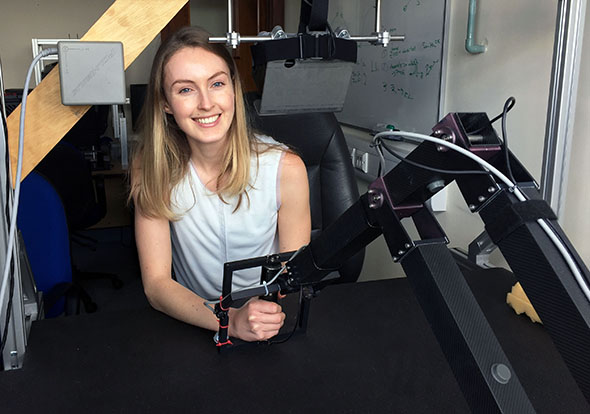As part of our Women in Engineering series, we meet Hannah Sheahan, PhD Candidate in the Computational and Biological Learning Lab (CBL).
What engineering offers is a toolkit of skills to help design a different world, one that meets the needs of women as well as men, which is ultimately empowering.
Hannah Sheahan PhD
Hi Hannah, how did you get into engineering?
At high school I became interested in maths and physics, mainly because it was the first time I’d been encouraged to think and problem solve. However when I thought about applying to university, dealing only with numbers every day seemed like it might be a little dreary, so I ultimately chose Engineering because it could provide technical challenge as well as a creative outlet through design.
Thankfully, I enrolled, despite some less than favourable advice from my high school careers advisor. “What could a female do in engineering?” she laughed, when I told her my plan.
What are you doing now and what are your plans for the future?
I moved to Cambridge from New Zealand in 2014 to start a PhD in the Computational and Biological Learning Lab with Professor Daniel Wolpert.
Starting out as a mechatronics engineer, I now work towards understanding the fundamental mechanisms behind the brain’s ability to control movement and learn motor skills.
At the moment I use human-robot interaction to see how people learn to move in new physics environments. Hopefully, as we discover more about how the brain learns motor control, technology can be designed to help people overcome differences in their physical abilities.
What motivates you?
Generally speaking I’m easily frustrated by inequalities. Studying motor control under an engineering framework enables me to tackle several at once: I’m developing research with potential to improve function and access to general society for people with motor disabilities, while also challenging gender and class inequality simply by succeeding as a female engineer from a lower socioeconomic background. Engineering can be used to build all sorts of bridges, and some of them are social.
What has helped your career?
Female role models in STEM have been hugely influential on me. The first time I remember being challenged at school was because of a high school math teacher who let me choose problems I found difficult or interesting in the textbook for homework. She turned math into my favourite class, and without that support I probably wouldn’t have considered a career as an engineer. Later on, leadership and academic scholarships helped instil confidence that while there were few women in my field, there were successful engineers around who believed in me.

Hannah with one of the robots she uses to study how humans learn motor skills.
How have you overcome challenges and knockbacks in your career?
When starting my undergraduate engineering degree, and then again beginning my PhD in Cambridge, I experienced quite substantial feelings of intellectual inadequacy. Couple this with a tendency towards anxiety and being noticeably different – one of the only women in my course or lab, and you have the perfect recipe for Imposter Syndrome. Thankfully, as soon as I started openly discussing these feelings, I realised how common they were and eventually reasoned that they probably weren’t grounded in truth.
How have you managed to balance family life and other interests with your career?
Honestly, I haven’t always been very good at keeping balance. In the past when I’ve become particularly fascinated by something I’ve tended to develop tunnel vision. Now I’m trying to keep everything in moderation, including moderation. Sport helps a lot. I have no excuse not to exercise since I study human movement, but playing football for the University and running in the summer forces me outside to breathe some fresh air and focus completely on something simple for a few hours.
I believe it’s critical to make time for friends in different fields to ensure your subject doesn’t become all you think or know about – they do their best to stop me becoming a boring person. It can be challenging splitting your time in so many directions, but spending time away from work ultimately helps me focus when I have to, and I’m beginning to realise just how important it is.
Do you have any role models?
Many, and none for exactly the same reason as any other. I admire my close friends for their drive in their respective subjects and interests outside them, my current and previous supervisors Daniel Wolpert and Claire Davies for their commitment to fostering intellectual curiosity and challenging people.
Do you have any advice for women who are considering pursuing a career in engineering?
I’m a strong believer than work should be soul restoring, not soul destroying – so my main piece of advice would be to choose a career path you’re passionate about. That being said, many women – myself included – due to differences in gendered upbringings step into engineering as an undergraduate without ever having designed or tinkered with technology, so don’t be put off if this is the case.
What engineering offers is a toolkit of skills to help design a different world, one that meets the needs of women as well as men, which is ultimately empowering. If having a hand in crafting technology around you is something you’re interested in, engineering is one way to do it.
This article has been edited from the University of Cambridge Engineering Diversity website.

